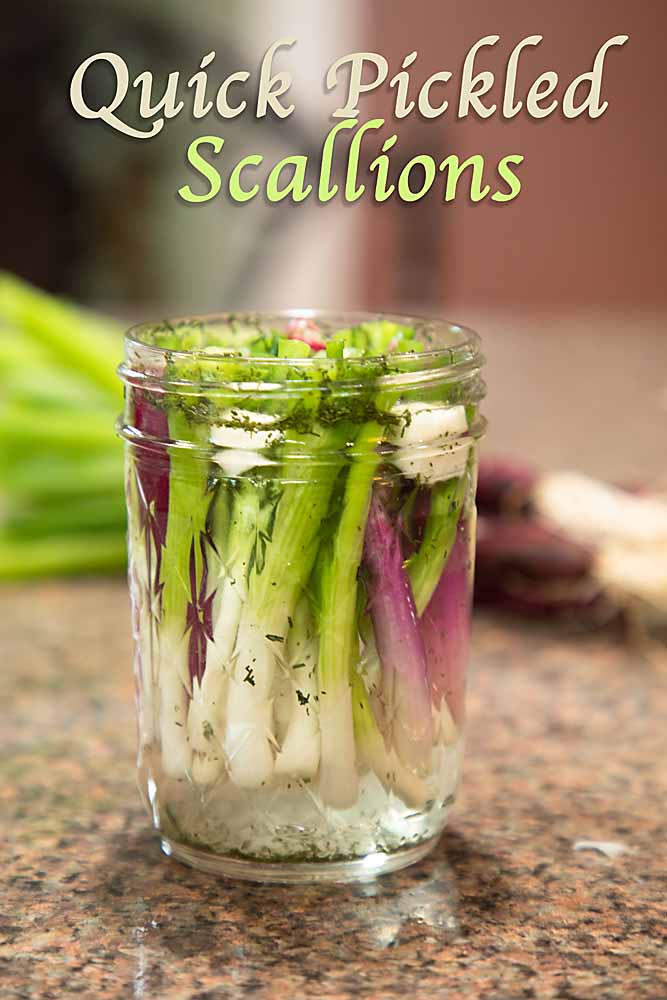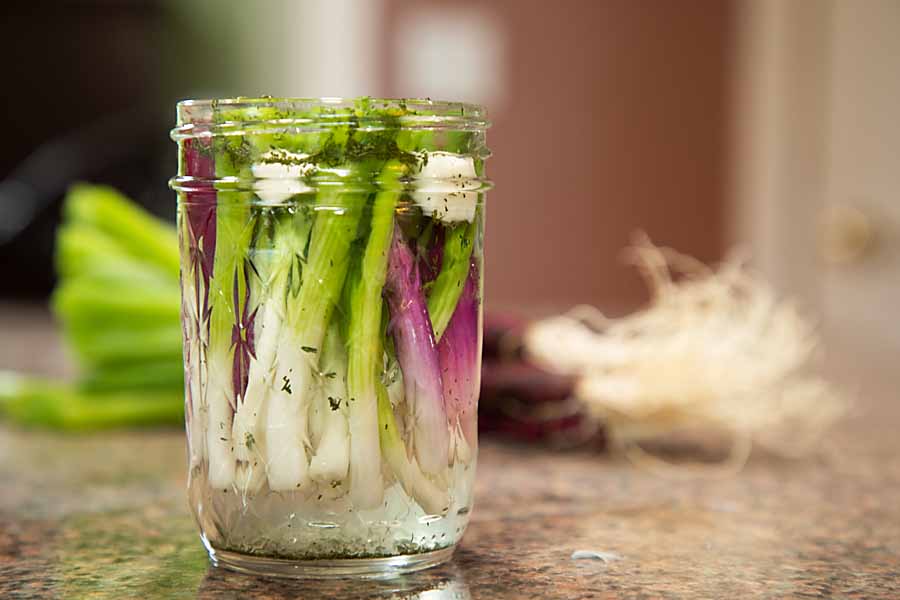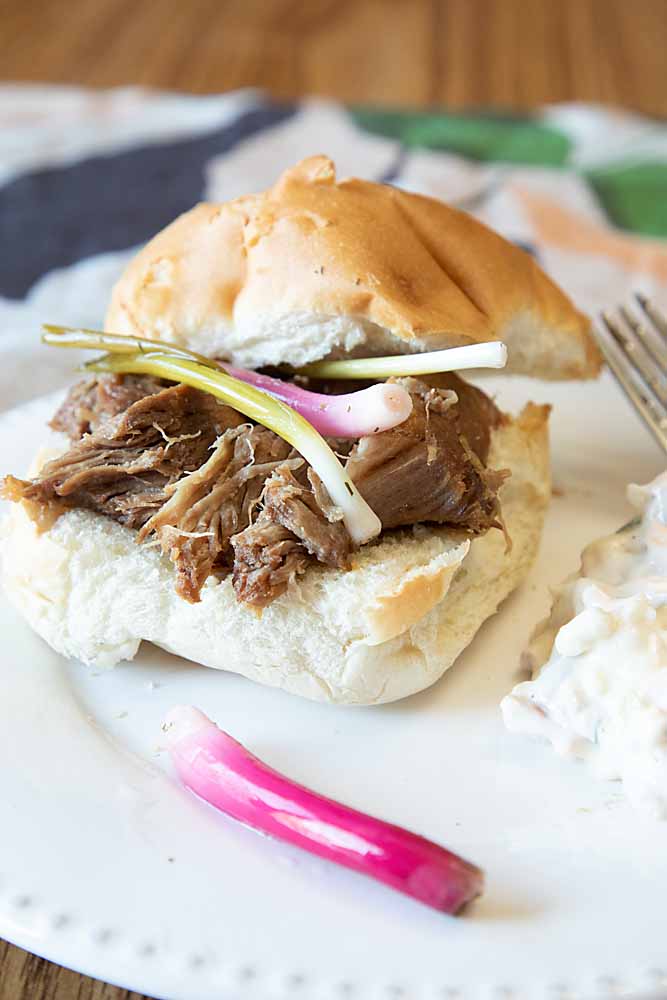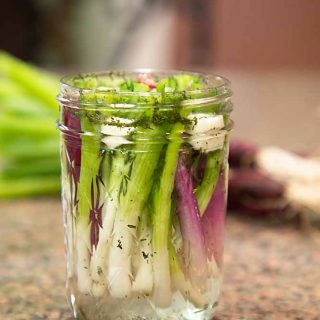Quick Pickled Scallions
With all the flavor of traditional pickles, but much less work, Quick Pickled Scallions can turn a green onion bounty into a taste treat! 
Pickles are big in our house. Years ago, I started making dill slices just to get rid of the big cucumbers from my CSAs. But they tasted so good on everything that they soon became a staple. Then I needed dozens of jars to get through the winter.
But the downside is that canning pickles is a project.
Clean the cucumbers, pre-soak, make the brine, boil a canner of water, pack the jars, then boil to process. Clearly not worth it unless you are doing a large volume.
Enter quick pickles.
Quick Pickle Advantages
Recently a member of my Sunday blogging group, just did a recipe for Quick Pickled Green Onions. 
Quick pickles, also known as refrigerator pickles, are a short-cut way to make homemade pickles. You mix up a few ingredients into a brine, pour it over your cleaned veggies and refrigerate. Without time-consuming activities like pre-soaking and water bath processing, they are… well, quick.
Perfect anytime you just have enough extra for a jar or two. 
Luckily, this just happened to coincide with a scallion bounty from my CSAs. When you do two CSAs, occasionally they both go crazy with the same item! Now I had a solution!
Of course there is one downside to quick pickles. It is that you have to keep the jar(s) in the refrigerator and use them up more quickly. But if you are using this method for a jar or two, it’s perfect!
Pickled Scallion Uses
When I decided to make my quick pickled scallions, I didn’t give much thought about what to use them for. But once done, they were really cute garnishing a recent cheese and charcuterie plate.
Then I put some on a pulled pork sandwich where they added an interesting flavor note. 
Of course, you can still slice them up and use them in salads, stir fries and scrambled eggs. Or anywhere else you use fresh green onions
Strike up another win for blogging buddies and CSA membership!

Quick Pickled Scallions
Ingredients
Brine:
- ¼ cup + 2 Tablespoons white distilled vinegar
- ¼ cup + 2 Tablespoons water
- 1 teaspoon granulated sugar
- 1 teaspoon non-iodized salt
Pickles:
- 2 large bunches green onions enough to fit jar
- 1 clove garlic halved or quartered
- 1/2 teaspoon dried dill
Instructions
- Place the brine ingredients in a small saucepan and bring to a boil over medium-high heat, stirring to dissolve the sugar and salt. Remove from heat and set aside.
- Clean green onions, then cut them ½ inch shorter than the height of a ½ pint canning jar. Put garlic and dill into jar, then pack the onions tightly into the jar, without smashing.
- Pour brine over onion, place lid and ring on jar and screw on snugly. Let the jars cool to room temperature, then store in the refrigerator.
Wait at least 48 hours for flavor to mature before enjoying them.
Makes ½ pint



In regard to this recipe & my prior long post: I’m sure your proportions of vinegar & salt are adequate. In fact, I think they are excessive for an 8 ounce jar. On the other hand, if the jar is very tightly packed, there won’t be room for 6 ounces of liquid, which is what your recipe calls for. The saving grace is that your brine is so strong, that even a couple of ounces are probably adequate. BUT, as I said…since the salt & vinegar concentration will ultimately be equal in pickles & the surrounding liquid…if the jar is not tightly packed, the scallions are gonna be outrageously salty. Hence, the genous of my dad’s method I mentioned before.
Glad you wrote again, Olen, since I had to pull your first comment from spam. As I’ve mentioned in prior comments, I doubt the vinegar is adequate for canning when I compare it to other recipes–just refrigerator preservation. On the salt, it’s very important in fermented pickles–the pickles preserved in a process like making sauerkraut. But I’ll quote the University of Tennessee Ag Department (https://bedford.tennessee.edu/extension-explores-preserving-pickled-fruits-and-vegetables/): “Salt is essential for the safety of fermented pickles and cannot be reduced. Although it is not required for the safety of quick pickles, it can greatly affect the flavor. Therefore, if you wish to make reduced-sodium pickles, there are two recipes in the USDA Guide to Canning. One is for Sliced Dill Pickles and one for Sliced Sweet Pickles. See the recipes above if you want to make reduced sodium pickles.” So per this, the salt should be able to be safely reduced, though I do tend to like my pickles on the salty side!
The problem with pickling using a standard brine is that, over time, the concentration of salt & vinegar will be equal in the pickles and the liquid in the jar. That means that a tightly packed jar will not have enough salt & vinegar for preservation, whereas a loosely packed jar will be too salty & acidic because more brine fit in around the food being pickled. My father, a sort of “mad scientist” noted that his pickles varied in saltiness & acidity when using a standard brine and solved the problem. It was a bit more tedious, because it was a 1 jar at a time process…but the results were always totally uniform. What he did was pack all of the jars, and then add the vinegar needed to reach the ideal concentration for a quart and fill to the top with water. Then, one at a time, he would pour out the liquid from one jar, into a small pot, to which he added the total ideal amount of salt, stir ’til dissolved. Poured it back into the same jar and capped it. Then go on to the next jar. He did not heat process the pickles and they lasted, literally, for years on the shelf. Darn thing is, everyone (even the experts) talks about the concentration of salt & vinegar in brine…NOT in the finished pickles…& I don’t remember the ratios Poppy used. I suspect it was about 2-3%, by weight, of salt, but I don’t know about the acidity…or, how much 5% vinegar is appropriate for a quart pickling jar. I’d sure like to hear from someone who can give the exact minimum amounts of salt & vinegar needed for a quart. And, again, whether the jar is tightly packed or not, those minimums need to be there or the product will spoil. With the right amount, refrigeration & “canning” in not needed.
You know I’ve sometimes had leftover brine and wondered how they could be so confident the acidity was correct for preservation. I always figured there was enough of a cushion for safety. Your father apparently thought along those lines and decided to do something to make it really accurate!
How long will they last in the refrigerator?
Official sources say 2-4 weeks, though I think a jar of mine got lost in the back of the fridge and was still good longer. It’s important that they stay covered for best longevity since the vinegar is what preserves them. Hope you get a chance to try these!
Do I need to let the brine cool before pouring over the scallions? I poured over the scallions while the brine was still hot and the scallions changed to a dark colour and the green tops went limp.
That’s what I did and I checked some other online recipes which were the same. Were your scallions not packed tighly–that would mean a higher amount of pickling liquid which might make some difference…
Can you hot water bath them also so no need to refrigerate?
Hi Kathy–I so get wanting to make foods that are shelf stable. I bought a pressure canner last year because I didn’t have room for broth in my freezer. Unfortunately, this recipe is designed to be kept in the refrigerator and I don’t think it has enough acid in the brine for water bath canning. I looked around to see if I could find a trusted site (like Ball’s Fresh Preserving or a university extension) that had a recipe and struck out. If you are on facebook, you might consider joining the Food in Jars canning group at https://www.facebook.com/groups/FoodinJarsCommunity . (It’s a closed group so you’d need to request to join.) I have found them to be a great source of advice and recipe options.
I love this idea!!! They look so pretty in the jar too!
I thought they were pretty too Thao! Nice bonus!
Another thing that I havent tried, I never even have thought of making a pickle out of scallions. Such a great idea, looks perfect on that pulled pork too.
I was pretty happy with how they tasted on the sandwich too!
This is a wonderful idea. I love pickled anything! I’m not averse to a small batch of pickles — but I use quick pickling methods like this. For my bread & butter pickles, I use the microwave!
Yes, it was kind of a V-8 moment for me!
What a great idea. I shall give this recipe a go next time I’ve got extra scallions
Yess! And I think it’s especially timely in the age of not wasting anything!